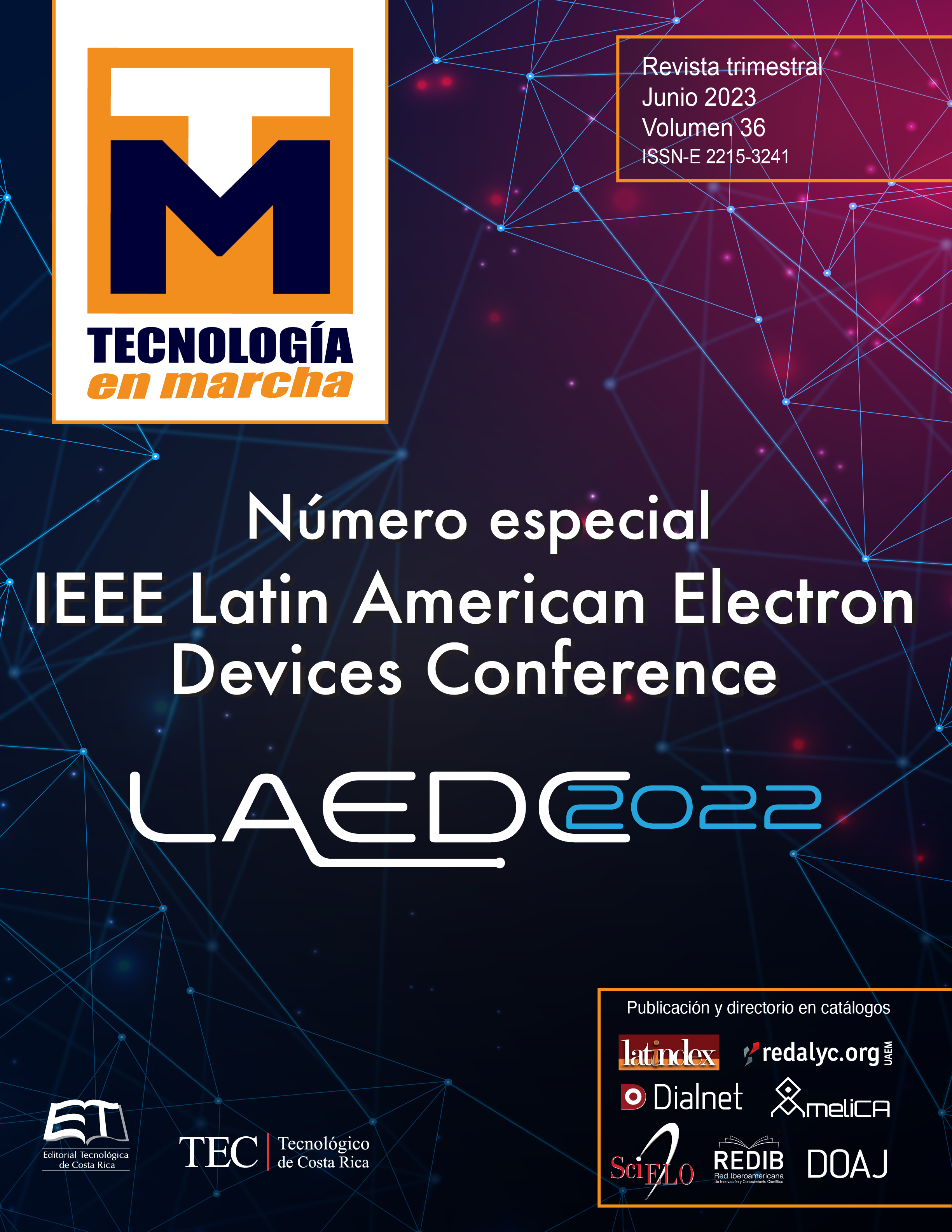Analysis of the stability of organic photovoltaic cells under indoor illumination
Main Article Content
Abstract
In this study, we analyze the degradation behavior of conventional polymeric solar cells
(PSCs) under constant indoor light illumination. A LED lamp with a color temperature of 2700 K, was used for the indoor light illumination conditions. We compare the results obtained with encapsulated and non-encapsulated devices. The performance of the PTB7:PC70BM-based cell showed an initial maximum power conversion efficiency (PCE) of 12.0% under the luminance of 1000 lux and maximum power density (MPP) of 45.7 μW/cm2. The work describes the results of the measurements and analysis of the degradation process, performed by a current density – voltage (J–V) characteristic curve study under LED light. The analyzed performance parameters were PCE, short circuit current density (JSC), open-circuit voltage (VOC) and fill factor (FF). The PCE of encapsulated devices remained above 80% of the initial value after 624 h.
Article Details

This work is licensed under a Creative Commons Attribution-NonCommercial-NoDerivatives 4.0 International License.
Los autores conservan los derechos de autor y ceden a la revista el derecho de la primera publicación y pueda editarlo, reproducirlo, distribuirlo, exhibirlo y comunicarlo en el país y en el extranjero mediante medios impresos y electrónicos. Asimismo, asumen el compromiso sobre cualquier litigio o reclamación relacionada con derechos de propiedad intelectual, exonerando de responsabilidad a la Editorial Tecnológica de Costa Rica. Además, se establece que los autores pueden realizar otros acuerdos contractuales independientes y adicionales para la distribución no exclusiva de la versión del artículo publicado en esta revista (p. ej., incluirlo en un repositorio institucional o publicarlo en un libro) siempre que indiquen claramente que el trabajo se publicó por primera vez en esta revista.
References
S. Ananthakumar, J. Kumar and S. Babu, “Third-Generation Solar Cells: Concept, Materials and Performance - An Overview,” de Emerging Nanostructured Materials for Energy and Environmental Science. Environmental Chemistry for a Sustainable World, Springer, Cham, 2019, vol. 23, pp. 305-339.
F. Martins, C. Felgueiras, M. Smitkova and N. Caetano, “Analysis of Fossil Fuel Energy Consumption and Environmental Impacts in European Countries,” Energies, vol. 12(6), no 964, 2019.
Y. Chu and P. Meisen, “Review and Comparison of Different Solar Energy Technologies,” Global Energy Network Institute, 2011.
P. Chengac and X. Zhan, “Stability of organic solar cells: challenges and strategies,” Chem. Soc. Rev., vol. 45, no 2544, pp. 2544-2582, 2016.
J. Gubbi, R. Buyya, S. Marusic and M. Palaniswami, “Internet of Things (IoT): A vision, architectural elements, and future directions,” Future Generation Computer Systems, vol. 29, no 7, pp. 1645-1660, 2013.
I. Mathews, S. N. Kantareddy and I. M. Peters, “Technology and Market Perspective for Indoor Photovoltaic Cells,” Joule, vol. 3, pp. 1415-1426, 2019.
L.-K. Ma, Y. Chen, P. C. Chow, K. S. Wong, S. K. So and H. Yan, “High-Efficiency Indoor Organic Photovoltaics with a Band-Aligned Interlayer,” Joule, vol. 4, pp. 1486-1500, 2020.
C. L. Cutting, M. Bag and D. Venkataraman, “Indoor light recycling: a new home for organic photovoltaics,” Journal of Materials Chemistry, vol. 4, pp. 10367-10370, 2016.
I. N. d. S. e. H. e. e. Trabajo, “Real Decreto 486/1997, de 14 de abril. Guía Técnica para la Evaluuación y Prevención de los Riesgos Relativos a la Utilización de los Lugares de Trabajo”.
Y.-J. You, C. E. Song, Q. V. Hoang, Y. Kang, J. S. Goo, D.-H. Ko, J.-J. Lee, W. S. Shin and J. W. Shim, “Highly Efficient Indoor Organic Photovoltaics with Spectrally Matched Fluorinated Phenylene-AlkoxybenzothiadiazoleBased Wide Bandgap Polymers,” Advances Functional Materials, vol. 29, no 27, 2019.
W. Chen, J. Zhang, G. Xu, R. Xue, Y. Li, Y. Zhou, J. Hou and Y. Li, “A Semitransparent Inorganic Perovskite Film for Overcoming Ultraviolet Light Instability of Organic Solar Cells and Achieving 14.03% Efficiency,” Advanced Materials, vol. 30, no 1800855, 2018.
K. Aitola, G. G. Sonai, M. Markkanen, J. J. Kaschuk, X. Hou, K. Miettunen and P. D. Lund, “Encapsulation of commercial and emerging solar cells with focus on perovskite solar cells,” Solar Energy, vol. 237, pp. 264-283, 2022.
S. Park and H. J. Son, “Intrinsic photo-degradation and mechanism of polymer solar cells: the crucial role of non-fullerene acceptors,” Journal of Materials Chemistry A, vol. 7, no 45, p. 25675–26188, 2019.
A. Sharma, M. Chauhan, J. Patel, M. K. Pandey, . B. Tripathi, . J. P. Tiwari and S. Chand, “Study of light-induced degradation of polymer: fullerene solar cells,” New Journal of Chemistry, 2022.
A. Abat Amelenan Torimtubun, J. G. Sánchez, J. Pallarès and L. F. Marsal, “Photostability Study of Inverted Polymer Solar Cells Under AM 1.5G and LED Illumination via Impedance Spectroscopy,” Journal of the Electron Devices Society, vol. 9, pp. 484-491, 2021.
M. Ramírez-Como, V.S. Balderrama, A. Sacramento, L.F. Marsal, G. Lastra and M. Estrada, “Fabrication and characterization of inverted organic PTB7:PC70BM solar cells using Hf-In-ZnO as electron transport layer,” Solar Energy, vol. 181, pp. 386-395, 2019.
M. Reese, S. Gevorgyan, M. Jørgensen, E. Bundgaard, S. Kurtz, D. Ginley, D. Olson, M. Lloyd, P. E. Katz, A. Elschner, O. Haillant, T. Currier, V. Shrotriya, M. Hermenau, M. Riede, K. Kirov, G. Trimmel and F. Krebs, “Consensus stability testing protocols for organic photovoltaic materials and devices,” Solar Energy Materials & Solar Cells, vol. 95, no 5, pp. 1253-1267, 2011.
L. Duan and A. Uddin, “Progress in Stability of Organic Solar Cells,” Advanced Science, vol. 7, no 11, 2020.

